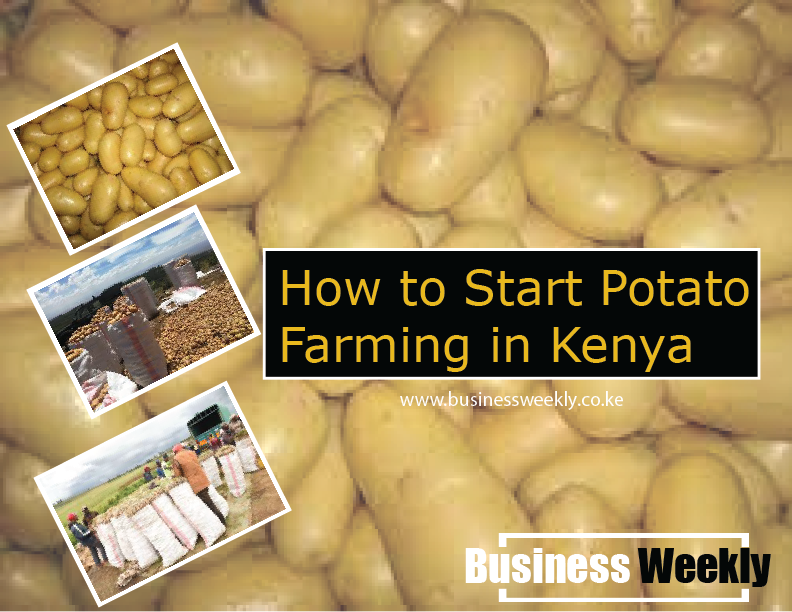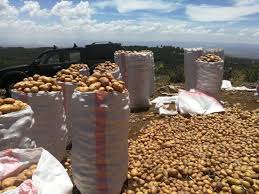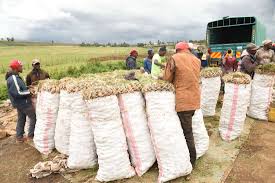How to Start Potato Farming in Kenya
10 min read
Coming up with a profitable business idea in Kenya is not an easy feat. But if you ever wanted to try your hand in potato farming would be a great business idea to consider. If you ever wanted to start potato farming in Kenya, this article is meant for you.
When done right –picking the right farmland for your potatoes, preparing the land well, planting the recommended seeds, and using the necessary chemicals, you can make a lot of money from potato farming.
The opposite is true.
Without the right information on how to start potato farming in Kenya, you will suffer huge losses. Keep reading to learn how to start potato farming in Kenya and succeed.
Step 1: Potato Farming in Kenya – Getting Started
Potatoes are categorized as highlands crops, commonly grown in the wetlands of Kenya. Some of the areas where this crop does well include Yata, Timboroa, Kinagop, Molo, Laikipia, and Taita Hills.
The first element to consider when going into potato farming should be the land. Your choice of the farmland will influence the overall yield. Some of the places you can consider for your potato farm, especially if you stay in Nairobi, are North Nyandarua and Kinangop.
Buying a land to start potato farming in Kenya is expensive, especially in the specified areas. The easiest way is to lease one. The lowest cost of leasing land in Nyandarua is around ksh. 15,000 a year.
So, what factors should you consider when picking a suitable land for potato farming in Kenya?
The ideal land should:
- Be near the main road, preferably 1-2 km from the tarmac
- Have reddish soil (toney)
- Have a good history of potato production
- Not be near a river to reduce cases of frost bite
Step 2: Preparing Land for Potato Farming
You’ve got the land. The next step is to prepare it for planting. Till the land first and build furrows where you will plant your seeds.
Look for locals to hire them for this task. The majority of farm laborers around these areas already know how to prepare land for potato farming. Make sure you get someone reliable, perhaps a family member, to help you manage the farm.
Do not forget to add manure to the land. Usually, you can get a lorry of animal manure from Masai land for as low as Ksh20,000, inclusive of transport costs.
Step 3: Go for Certified Potato Seeds
One of the reasons why most potato farmers don’t make a lot of money from this venture is using the wrong seeds. Resist the urge of buying your seeds from the local farmers and instead, go for certified potato seeds. The rationale for this is that certified seeds are not only disease-free but also will give you the best harvest.
Kisima Foundation is one of the most reliable suppliers of potato seeds you can consider. A bag of certified potato seeds will cost you around ksh 3,000 – 4,000.
Buying certified seeds isn’t all there is –it is important to ask the local farmers for recommendations on the best potato breads. Some favorable options include Shangi, Asante, Kenya Mpya, and Tigoni.
Here are the key factors to consider when choosing potato seeds:
- Yield potential
- Maturity period
- Pest and disease tolerance
- Tuber characteristics
- Intended purpose of the produce
Step 4: Potato Planting
After planting, your potatoes will take around 3 months to mature. However, for better yields, potatoes need enough water and fertilizer. Where rainwater is not enough, you can opt for irrigation.
For better yields, consider using DAP fertilizer alongside your animal manure and weed extensively. In addition, get yield boosters and the necessary chemicals for pest prevention and better yield from a local agrovet shop.
- Land Preparation and Planting
Here’s a step-by-step potato farming planting process to follow:
- Prepare the land where the potatoes are to be planted. Add compost manure and or fertilizer as advised (see below).
- Potatoes are commonly grown in hilled rows. This involves digging shallow trenches 70–95 cm apart.
- Space the potato seeds 30 cm apart.
- Before covering, mix 40ml AFRIKELP and 20ml RODAZIM in 20 Litres water and apply to the tubers in the trench.
- Cover with 7.5 cm of soil.
- When the plants reach about 25 cm in height,
- Mound the soil up around the stems of the plants so that they are covered up to about half of their height. This protects shallow tubers from turning green from exposure to sunlight.
- Allow the plants to grow another 25 cm and again mound the soil.
- Add another spray of fertilizer. This will ensure strong root growth
- Feeding and Potato Care
In order to ensure maximum yields, make sure the crop is well fed from the early stages.
- Soil testing in a good laboratory will enable you to make the best decision on fertilizer application.
- Use of plant or animal compost manure is recommended, but it should be well matured and free from weed seeds and other pests/diseases. Ideally, it should be applied when dry, and at least a week before planting.
- You can start with a Phosphorus fertilizer (DAP, 150kg/Acre) during planting.
- Remember to apply other types of fertilizers such as AFRIKELP 40ml/20ltr plus RODAZIM 20ml/20Ltr also during planting, to ensure strong root development, and protection against disease.
- Using HARMONY at 25-40ml/20ltr from week 2 will guarantee strong foliar growth in any conditions. You can continue application every two weeks up to 4-6 applications in total. (If the soil condition is rather poor, or if there are more stressful conditions like too much rain, or heavy pest/ disease pressure, increase the dose up to 60ml/20ltrs). This will increase your yields significantly while enhancing your soil fertility. There is generally no further need for topdressing with granular fertilizer, if this is done.
Common Potato Pests and Diseases
Potato farming is adversely affected by the attack by numerous pests and diseases.
Potato Pests
Let’s look at the common potato pests
- Tuber moths– these are white-flying insect pests whose larvae enter directly into tuber making slender tunnels along or deep into the tubers. These tunnels don’t heal thus provide avenues for entry of other pathogens, e.g. diseases like soft and dry rot.
Solution: Spray ESCORT® 19EC 10ml/20L or BACIGUARD® 16WDG 15g/20L or OCCASION STAR® 200SC 3ml/20L or LEXUS® 247SC 8ml/20L
- Root knot nematodes– they are microscopic parasites living in the soil which feed on the roots. The infested tubers develop swellings, making them unattractive.
Solution: Drench the planting holes with ALONZE® 50EC 10ml/20L or mix basal fertilizer, 50kg with 2kg of ADVENTURE® 0.5GR.
- Leafminers– they feed between the upper and lower epidermal leaf surfaces creating whitish serpentine or blister mines. This reduces the surface area for photosynthesis leading to stunting and reduced yields.
Solution: Spray ALONZE® 50EC 5ml/20L or ESCORT® 19EC 10ml/20L or LEXUS® 247SC 8ml/20L or OCCASION STAR® 200SC 3ml/20L
- Aphids; these are tiny black and green soft –bodied insects which suck sap from leaves and stems of plants causing leaf curling and distortion and as they feed, they also secrete honeydew which facilitates the development of sooty mold. Aphids are also vectors of diseases like Potato Leaf Roll disease.
Solution: Spray KINGCODE ELITE® 50EC 10ml/20L or PENTAGON® 50EC 10ml/20L or LEXUS® 247SC 8ml/20L. To get rid of the sooty mold, spray JAMBO CLEAN® 100ml/20L.
- Whiteflies; are tiny white winged insects which suck sap from the plants causing damages and reducing plant vigour. As they feed, they produce honeydew which induces growth of sooty molds. They are also vectors for plant diseases.
Solution: Spray TAURUS® 500SP 10g/20L or LEXUS® 247SC 8ml/20L or KINGCODE ELITE® 50EC 10ml/20L. Also, spray the crop with JAMBO CLEAN® 100ml/20L to clean the sooty mold.
Major Potato Diseases
The common diseases that might affect your potatoes include the following:
- Late blight– it attacks leaves, stem and tubers. Infection leads to development of small pale to dark green spots that later turn into brown or black lesions, which appear water-soaked during conditions of high humidity and cool temperatures.
Solution: Spray GEARLOCK TURBO® 250WP 25g/20L or FORTRESS GOLD® 720WP 40g/20L or TOWER® 720WP 50g/20L
- Bacterial wilt– this is commonly spread by infested tubers and develops faster in areas with poor drainage. Infection causes stunting and wilting. When the stem or tubers of an infected crop are cut, whitish droplets of bacterial cream ooze out of them. Solution: Spray GREENCOP® 500WP 50g/20L, a copper-based products which suppress the activity of the pathogen.
- Potato leaf roll– this is a viral disease, usually transmitted by aphids. Infected leaves roll/fold and do not broaden, and this reduces the photosynthetic surface area, eventually causing stunted growth. Solution: Spray KINGCODE ELITE® 50EC 10ml/20L or PENTAGON® 50EC 10ml/20L or LEXUS® 247SC 8ml/20L to control the vectors (aphids).
- Fusarium Wilt; On infection, the symptoms appear like vein clearing on the younger leaves and dropping of the older lower leaves, which subsequently turn yellow and wilt. Yellowing and wilting progress up the stems and tubers which develop brown discolouration. Vascular tissue become brown but do not produce a slimy substance when cut under water like in bacterial wilt. Solution: Drench with GREENCOP® 500WP 100g/20L. Use Foliar spray PYRAMID® 700WP 50g/20L or ABSOLUTE® 375SC 10ml/20L after every 2 weeks.
- Early blight– it majorly affects the leaves and stems and can cause considerable defoliation if not controlled in time resulting in to reduced yields. Infection leads to formation of brown circular spots on leaves and stems.
Solution: Spray FORTRESS GOLD® 720WP 40g/20L or TOWER® 720WP 50g/20L or RANSOM® 600WP 15g/20L or ABSOLUTE® 375SC 10ml/20L
Tips For Buying Chemicals
The chemicals you will buy depend on different potato diseases
For instance,
- If you notice small wounds on potato roots apply nematicides
- If the potatoes develop signs of blight, consider using fungicides
Potato Harvesting and Storage
Potatoes are ready for harvesting approximately 4 weeks after flowering. Observe the vines for signs of senescence (drying out). Some farmers cut back the stems to encourage hardening, for a period of 3 or 4 weeks.
- Use a fork jembe when harvesting to prevent excessive damage to tubers.
- Store the tubers in cool, dry conditions, away from direct sunlight for maximum shelf-life.
Potato Farming – How To Get Market for Your Potatoes
One of the key challenges of potato farming in Kenya is finding the right market and best prices. You can either sell to brokers or to end users. In the potato farming sector, there are numerous brokers who have made it quite hard for farmers to get their produce to the end users. These brokers play a significant role in the potato farming sector in Kenya; they will buy your produce off the farm relieving you off the stress of looking for market for your produce. Nevertheless, their prices are at times unreasonably low, so it is critical to devise a working strategy to deal with this problem.
So, how do you deal with the low prices from potato brokers?

First, have your potatoes at a time when the supply is low and the prices are favorable. Usually, the supply of potatoes is low around February and March.
If you plant around December, you will have enough produce to supply in February and March at a time when the prices are favorable Ksh4,000 and above for a bag.
First, have your potatoes at a time when the supply is low and the prices are favorable. Usually, the supply of potatoes is low around February and March. If you plant at around December, you will have enough produce to supply in February and March at a time when the prices are favorable Ksh4,000 and above for a bag.
Secondly, you can hold your potatoes and sell them when the demand is high. Look for granaries, such as the ones constructed by government and non-governmental institutions to keep your potatoes there until the market stabilizes.
Third, look for the market yourself. At times, prices can go low even at the times you expect to be high. So, instead of waiting and play with the seasons, why don’t you look for the market yourself?
Combine several sales and marketing strategies to find market for your produce. For instance, approach schools, institutions, fast-food chains, restaurants, etc and offer them a favorable quote.
Another approach would be to hire a lorry and transport your potatoes to the villages where you can sell directly to local consumers and retailers. While this approach might appear quite involving, you get to dictate the price and you are assured of better returns.
How Much Money Do You Need to Start Potato Farming in Kenya?
To start potato farming in Kenya, you will need about ksh80,000 from planting to harvesting for an acre of land.
So how much do you expect to make from Potato farming in Kenya? How Much To Expect
Currently, a bag of Shangi potatoes goes for Ksh4,000. It is estimated that an acre of land will give you around 80 bags of potatoes in 90 days.
So let’s do the math.
Revenue: Ksh4,000 x 80 bags = Ksh320,000.00
Net Profit in 3 Months: Ksh320,000 (Revenue) – Ksh80,000 (Expenses) = Ksh240,000
NB: The National Potato Council of Kenya recommends the size of potato bag to be 110 kilograms and not the ordinary 90kgs.

Final Thoughts on Potato Farming in Kenya
Potato farming in Kenya is a brilliant business idea that may not require unnecessarily huge capital investment. However, if you get into potato farming without understanding all the necessary information, you can easily lose a lot of money. We hope that this article has laid the necessary foundation for how to start potato farming in Kenya successfully.
What do you think –Are you ready to start potato farming? Let us know what is stopping you from starting.








1 thought on “How to Start Potato Farming in Kenya ”